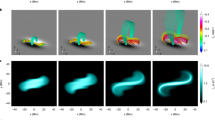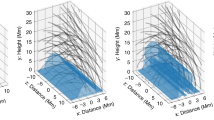Abstract
Magnetically driven eruptions on the Sun, from stellar-scale coronal mass ejections1 to small-scale coronal X-ray and extreme-ultraviolet jets2,3,4, have frequently been observed to involve the ejection of the highly stressed magnetic flux of a filament5,6,7,8,9. Theoretically, these two phenomena have been thought to arise through very different mechanisms: coronal mass ejections from an ideal (non-dissipative) process, whereby the energy release does not require a change in the magnetic topology, as in the kink or torus instability10,11; and coronal jets from a resistive process2,12 involving magnetic reconnection. However, it was recently concluded from new observations that all coronal jets are driven by filament ejection, just like large mass ejections13. This suggests that the two phenomena have physically identical origin and hence that a single mechanism may be responsible, that is, either mass ejections arise from reconnection, or jets arise from an ideal instability. Here we report simulations of a coronal jet driven by filament ejection, whereby a region of highly sheared magnetic field near the solar surface becomes unstable and erupts. The results show that magnetic reconnection causes the energy release via ‘magnetic breakout’—a positive-feedback mechanism between filament ejection and reconnection. We conclude that if coronal mass ejections and jets are indeed of physically identical origin (although on different spatial scales) then magnetic reconnection (rather than an ideal process) must also underlie mass ejections, and that magnetic breakout is a universal model for solar eruptions.
This is a preview of subscription content, access via your institution
Access options
Access Nature and 54 other Nature Portfolio journals
Get Nature+, our best-value online-access subscription
$29.99 / 30 days
cancel any time
Subscribe to this journal
Receive 51 print issues and online access
$199.00 per year
only $3.90 per issue
Buy this article
- Purchase on Springer Link
- Instant access to full article PDF
Prices may be subject to local taxes which are calculated during checkout




Similar content being viewed by others
References
Webb, D. F. & Howard, T. A. Coronal mass ejections: observations. Living Rev. Sol. Phys. 9, 3 (2012)
Shibata, K. et al. Observations of x-ray jets with the Yohkoh soft x-ray telescope. Publ. Astron. Soc. Jpn 44, L173–L179 (1992)
Shimojo, M. et al. Statistical study of solar x-ray jets observed with the Yohko soft x-ray telescope. Publ. Astron. Soc. Jpn 48, 123–136 (1996)
Savcheva, A. et al. A study of polar jet parameters based on Hinode XRT observations. Publ. Astron. Soc. Jpn 59, S771–S778 (2007)
Shibata, K. Evidence of magnetic reconnection in solar flares and a unified model of flares. Astrophys. Space Sci. 264, 129–144 (1998)
Innes, D. E., Genetelli, A., Attie, R. & Potts, H. E. Quiet Sun mini-coronal mass ejections activated by supergranular flows. Astron. Astrophys. 495, 319–323 (2009)
Innes, D. E., McIntosh, S. W. & Pietarila, A. STEREO quadrature observations of coronal dimming at the onset of mini-CMEs. Astron. Astrophys. 517, L7 (2010)
Raouafi, N.-E., Georgoulis, M. K., Rust, D. M. & Bernasconi, P. N. Micro-sigmoids as proginators of coronal jets: is eruptive activity self-similary multi-scaled? Astrophys. J. 718, 981–987 (2010)
Schrijver, C. J. Eruptions from solar ephemeral regions as an extension of the size distribution of coronal mass ejections. Astrophys. J. 710, 1480–1485 (2010)
Török, T. & Kliem, B. Confined and ejective eruptions of kink-unstable flux ropes. Astrophys. J. 630, L97–L100 (2005)
Kliem, B. & Török, T. Torus instability. Phys. Rev. Lett. 96, 255002 (2006)
Yokoyama, T. & Shibata, K. Magnetic reconnection as the origin of X-ray jets and Hα surges on the Sun. Nature 375, 42–44 (1995)
Sterling, A. C., Moore, R. L., Falconer, D. A. & Adams, M. Small-scale filament eruptions as the driver of X-ray jets in solar coronal holes. Nature 523, 437–440 (2015)
Zhang, Q. M. et al. Explosive chromospheric evaporation in a circular-ribbon flare. Astrophys. J. 827, 27 (2016)
Pariat, E., Antiochos, S. K. & DeVore, C. R. A model for solar polar jets. Astrophys. J. 691, 61–74 (2009)
Wyper, P. F., DeVore, C. R., Karpen, J. T. & Lynch, B. J. Three-dimensional simulations of tearing and intermittency in coronal jets. Astrophys. J. 827, 4 (2016)
Nishizuka, N. et al. Giant chromospheric anemone jet observed with Hinode and comparison with magnetohydrodynamic simulations: evidence of propagating Alfvén waves and magnetic reconnection. Astrophys. J. 683, L83–L86 (2008)
Antiochos, S. K. Helicity condensation as the origin of coronal and solar wind structure. Astrophys. J. 772, 72 (2013)
Martin, S. Conditions for the formation and maintenance of filaments. Sol. Phys. 182, 107–137 (1998)
Antiochos, S. K., DeVore, C. R. & Klimchuk, J. A. A model for solar coronal mass ejections. Astrophys. J. 510, 485–493 (1999)
Karpen, J. T., Antiochos, S. K. & DeVore, C. R. The mechanisms for the onset and explosive eruption of coronal mass ejections and eruptive flares. Astrophys. J. 760, 81 (2012)
Shibata, K. & Uchida, Y. Sweeping-magnetic-twist mechanism for the acceleration of jets in the solar atmosphere. Sol. Phys. 103, 299–310 (1986)
Moore, R. L., Sterling, A. C. & Falconer, D. A. Magnetic untwisting in solar jets that go into the outer corona in polar coronal holes. Astrophys. J. 806, 11 (2015)
DeVore, C. R. & Antiochos, S. K. Homologous confined filament eruptions via magnetic breakout. Astrophys. J. 680, 740–756 (2008)
Shibata, K. et al. Chromospheric anemone jets as evidence of ubiquitous reconnection. Science 318, 1591–1594 (2007)
De Pontieu, B. et al. The origins of hot plasma in the solar corona. Science 331, 55–58 (2011)
Ellerman, F. Solar hydrogen “bombs”. Astrophys. J. 46, 298–300 (1917)
Vissers, G. J. M., van der Voort, L. & Rutten, R. J. Ellerman bombs at high resolution. II. Triggering, visibility, and effect on upper atmosphere. Astrophys. J. 774, 32 (2013)
Brandt, P. N. et al. Vortex flow in the solar photosphere. Nature 335, 238–240 (1988)
Acknowledgements
P.F.W. was supported by a Royal Astronomical Society Fellowship at Durham University and previously by a NASA Postdoctoral Program Fellowship at NASA Goddard Space Flight Center. S.K.A. and C.R.D. were supported by NASA ‘Living With a Star’ and Heliophysics Supporting Research grants. The numerical simulations were supported by NASA High-End Computing allocations to C.R.D. on discover at NASA’s Center for Climate Simulation.
Author information
Authors and Affiliations
Contributions
P.F.W. designed and performed the numerical simulations, created the graphical outputs, and drafted the manuscript. S.K.A. conceived the investigation, consulted on the simulations, and revised the manuscript. C.R.D. developed the numerical model, assisted in designing the experiments, acquired the computer resources required, and revised the manuscript.
Corresponding author
Ethics declarations
Competing interests
The authors declare no competing financial interests.
Additional information
Reviewer Information Nature thanks K. Shibata and the other anonymous reviewer(s) for their contribution to the peer review of this work.
Publisher's note: Springer Nature remains neutral with regard to jurisdictional claims in published maps and institutional affiliations.
Extended data figures and tables
Extended Data Figure 1 Estimate of the speed of the flux rope during the slow-rise phase.
a, Current density (saturated at 6 × 10−3 A m−2) in the z = 0 plane; x and y are the vertical and horizontal Cartesian coordinates. The green dot shows the position near the centre of the flux rope that is tracked in time. b, Inferred speed of the flux rope axis (diamond symbols); the solid line shows these data after applying a two-point boxcar smoothing.
Extended Data Figure 2 Example of a mini-filament jet.
A large coronal jet produced in conjunction with the eruption of a mini-filament23, as seen by the Solar Dynamics Observatory’s Atmospheric Imaging Assembly in Fe xii at wavelength λ = 193 Å. a–c, Images prior to the jet (a), during the jet (b) and after the jet (c). The inferred coronal loop structure is depicted in white in a. We are grateful to R. L. Moore for providing the unpublished video from which these images were extracted.
Extended Data Figure 3 The block-adapted mesh during the jet, in the z = 0 plane at t = 32 min 40 s.
Each box corresponds to a block of 8 × 8 × 8 cells. Grid parameters are chosen to refine in regions of medium- to high-current density, shown as regions of white and red. The grid increases in size by a factor of four during the simulation, and the minimum resolution is 104 km.
Supplementary information
The simulated mini-filament jet evolution
See Figure 1 and text for descriptions of the evolution and field lines/shading depicted. (MOV 80354 kb)
3D visualisation of the jet
See Figure 2 and text for descriptions of the evolution and field lines/iso-surfaces depicted. (MOV 69623 kb)
Mini-filament jet example
See Extended Data Figure 2 and text for description. (MOV 123150 kb)
Evolution of the flux rope during the slow rise phase
See Extended Data Figure 1 and Methods for descriptions of the shading the method for following the flux rope. (MOV 329 kb)
Rights and permissions
About this article
Cite this article
Wyper, P., Antiochos, S. & DeVore, C. A universal model for solar eruptions. Nature 544, 452–455 (2017). https://doi.org/10.1038/nature22050
Received:
Accepted:
Published:
Issue Date:
DOI: https://doi.org/10.1038/nature22050
This article is cited by
-
Direct imaging of magnetohydrodynamic wave mode conversion near a 3D null point on the sun
Nature Communications (2024)
-
Circular-ribbon flares and the related activities
Reviews of Modern Plasma Physics (2024)
-
Developments of a fundamental mechanism for initiation of solar eruptions
Reviews of Modern Plasma Physics (2024)
-
Computation of Winding-Based Magnetic Helicity and Magnetic Winding Density for SHARP Magnetograms in Spherical Coordinates
Solar Physics (2023)
-
Magnetic reconnection in the era of exascale computing and multiscale experiments
Nature Reviews Physics (2022)
Comments
By submitting a comment you agree to abide by our Terms and Community Guidelines. If you find something abusive or that does not comply with our terms or guidelines please flag it as inappropriate.



